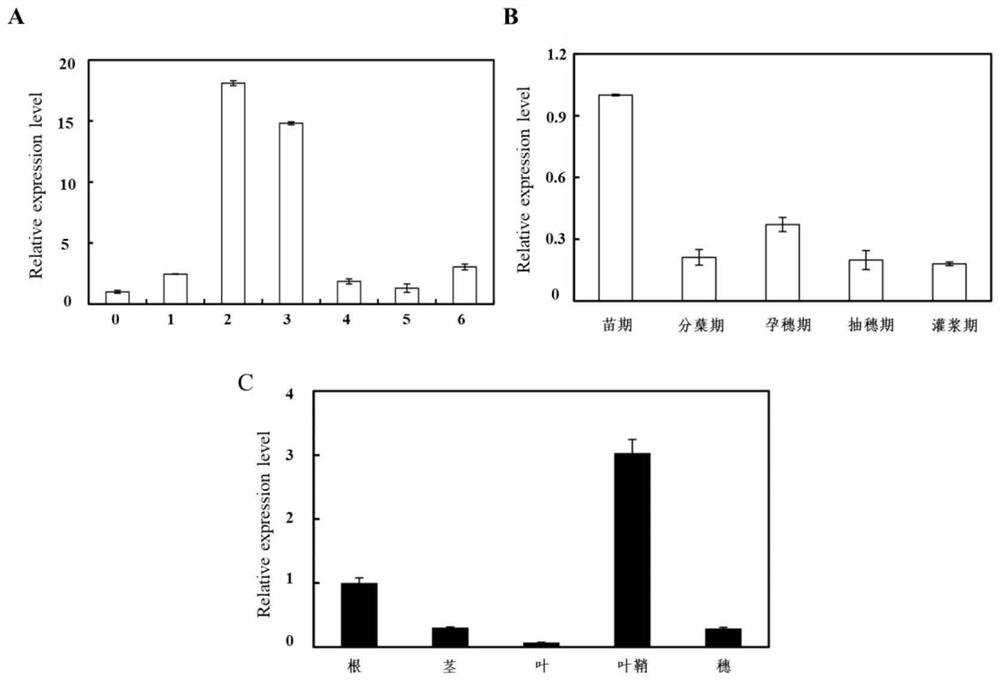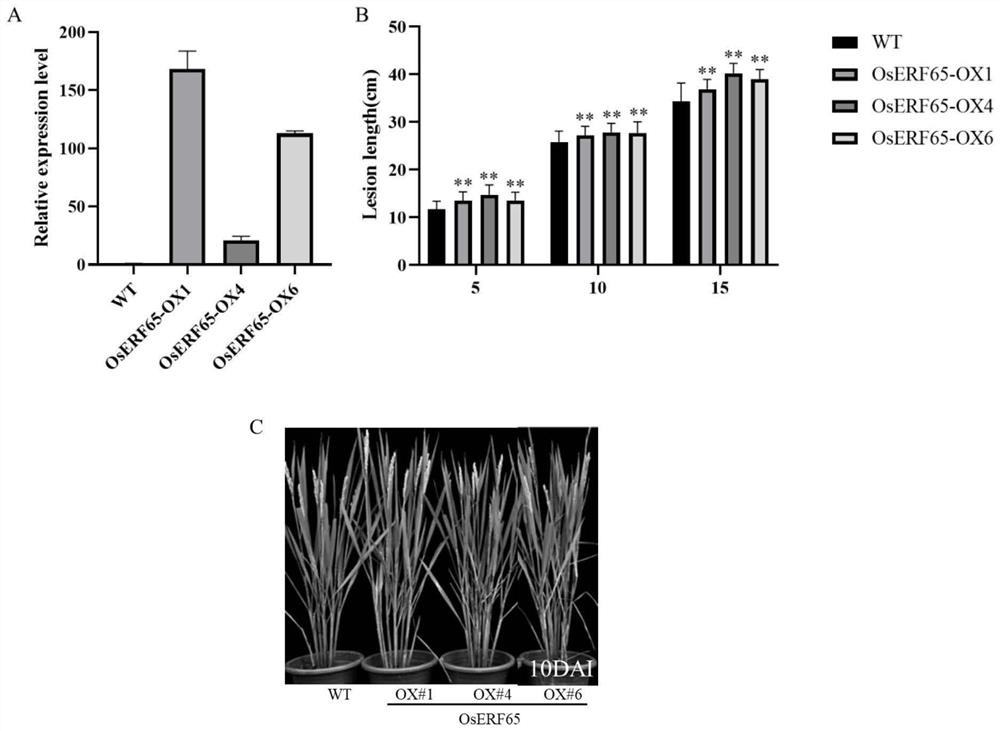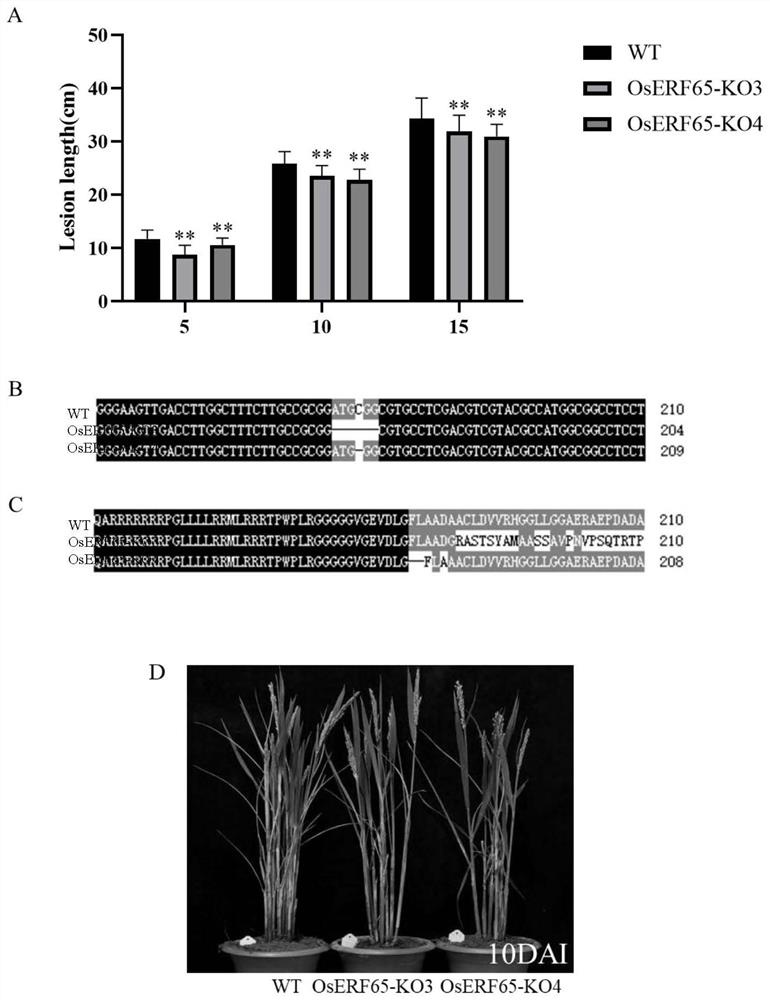Application of gene OsERF65 related to plant disease resistance
A disease resistance, gene technology, applied in the field of plant genetic engineering
- Summary
- Abstract
- Description
- Claims
- Application Information
AI Technical Summary
Problems solved by technology
Method used
Image
Examples
Embodiment 1
[0044] Example 1: Analysis of the expression characteristics of the OsERF65 gene
[0045] Samples of rice variety Xudao 3 at different growth stages were taken and stored in liquid nitrogen. Cultivate Xudao 3 under normal conditions until the end of tillering stage to inoculate with sheath blight bacteria, cut off the rice leaf sheaths 1cm above and below the inoculum before inoculation (0h) and 12h, 24h and 48h after inoculation, and store them in liquid nitrogen . According to the steps of the manual (Invitrogen Company), the total RNA of each rice sample was extracted with Trizol, and then the total RNA was digested with DNaseI (RNase free, Promega Company) to remove genomic DNA contamination (see the DNaseI manual for the method), and then reverse transcriptase (TaKaRa Company) reverse-transcribed the total RNA to synthesize the first strand of cDNA (for the method, refer to the manual of reverse transcriptase), the reaction conditions were: 37°C, 30min; 85°C, 5min; 4°C, ...
Embodiment 2
[0047] Example 2 Vector Construction, Genetic Transformation and Detection
[0048] The main steps of constructing the knockout vector are as follows: (1) Design the gene knockout target; (2) Amplify the sgRNA cassette. Using the pYLgRNA-OsU6a / LacZ plasmid as a template, the OsU6a-target fragment and the gRNA-target fragment were amplified in two reaction systems, respectively. (3) Construct the p-cas9 / gRNA knockout vector; (4) Select positive clones and confirm by sequencing; positive clone plasmids and final vector plasmids are mixed for recombination reaction; (5) PCR and plasmid digestion verify positive clones; (6) The recombinant positive plasmid is transferred into Agrobacterium; (7) Verification and preservation of positive Agrobacterium single clone. Two transgenic lines were obtained in the experiment, named OsERF65-KO3 and OsERF65-KO4 respectively.
[0049] The main steps of the construction of the overexpression vector are as follows: high-fidelity DNA polymerase...
Embodiment 3
[0050] Example 3 Identification of resistance to sheath blight of transgenic rice
[0051] The identification of sheath blight resistance was inoculated by the toothpick embedding method, and the strain was the medium-strong pathogenic strain YN-7 provided by the Plant Protection Department of Yangzhou University. For the identification of resistance at the adult plant stage in the greenhouse, the present invention uses 3 transgenic lines and 3 plants of the control wild type to be cultivated outdoors until the end of tillering stage, and then inoculated under high temperature and high humidity conditions in the greenhouse, and investigated 5 days, 10 days and 15 days after inoculation. Lesion length in days.
[0052] The results showed that the length of sheath blight lesions in the transgenic overexpression line was significantly higher than that of the wild type ( figure 2 A, B, C), the length of the sheath blight lesion of the knockout line was significantly lower than t...
PUM
 Login to View More
Login to View More Abstract
Description
Claims
Application Information
 Login to View More
Login to View More - R&D
- Intellectual Property
- Life Sciences
- Materials
- Tech Scout
- Unparalleled Data Quality
- Higher Quality Content
- 60% Fewer Hallucinations
Browse by: Latest US Patents, China's latest patents, Technical Efficacy Thesaurus, Application Domain, Technology Topic, Popular Technical Reports.
© 2025 PatSnap. All rights reserved.Legal|Privacy policy|Modern Slavery Act Transparency Statement|Sitemap|About US| Contact US: help@patsnap.com



